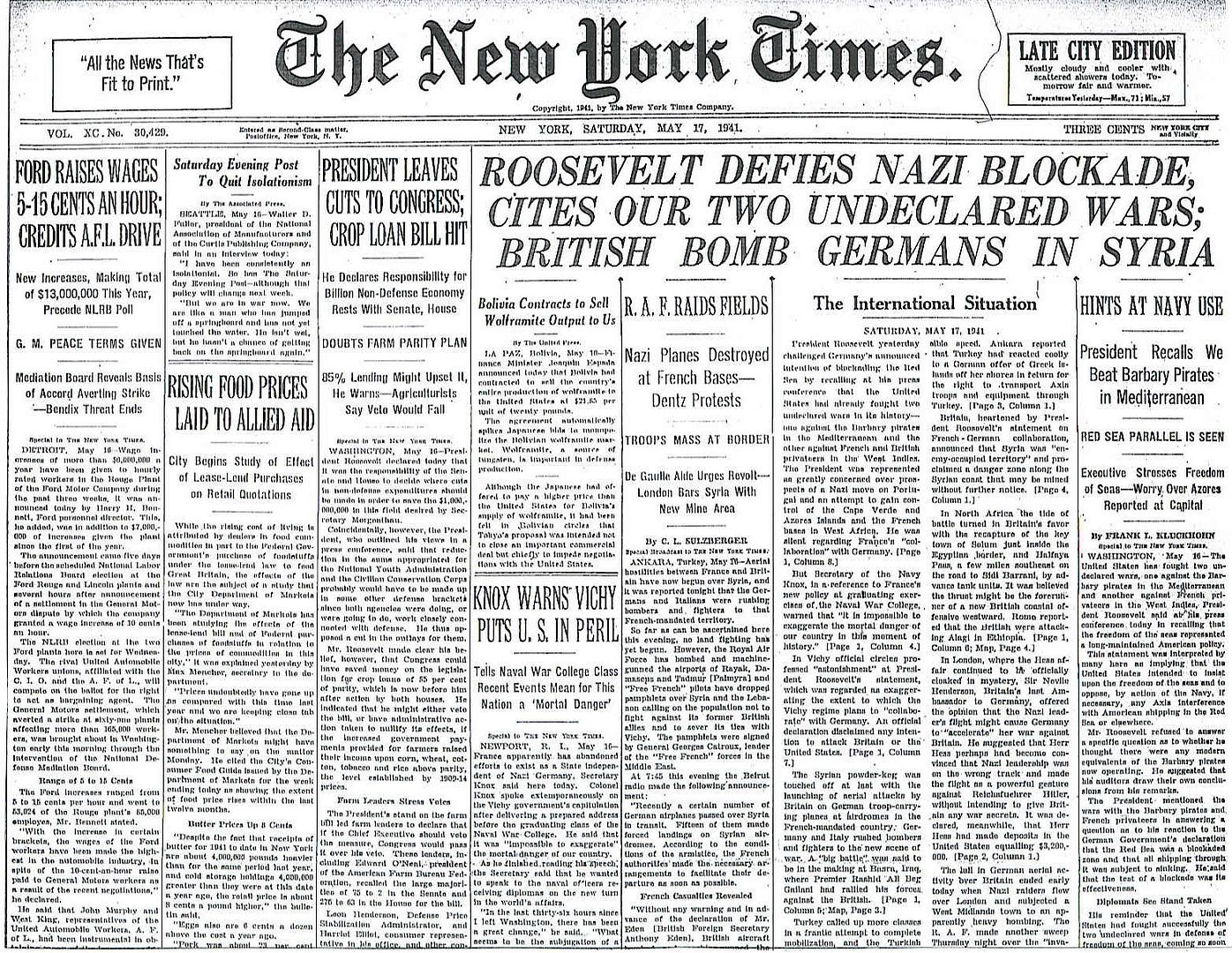
Posted on 05/17/2011 4:52:41 AM PDT by Homer_J_Simpson



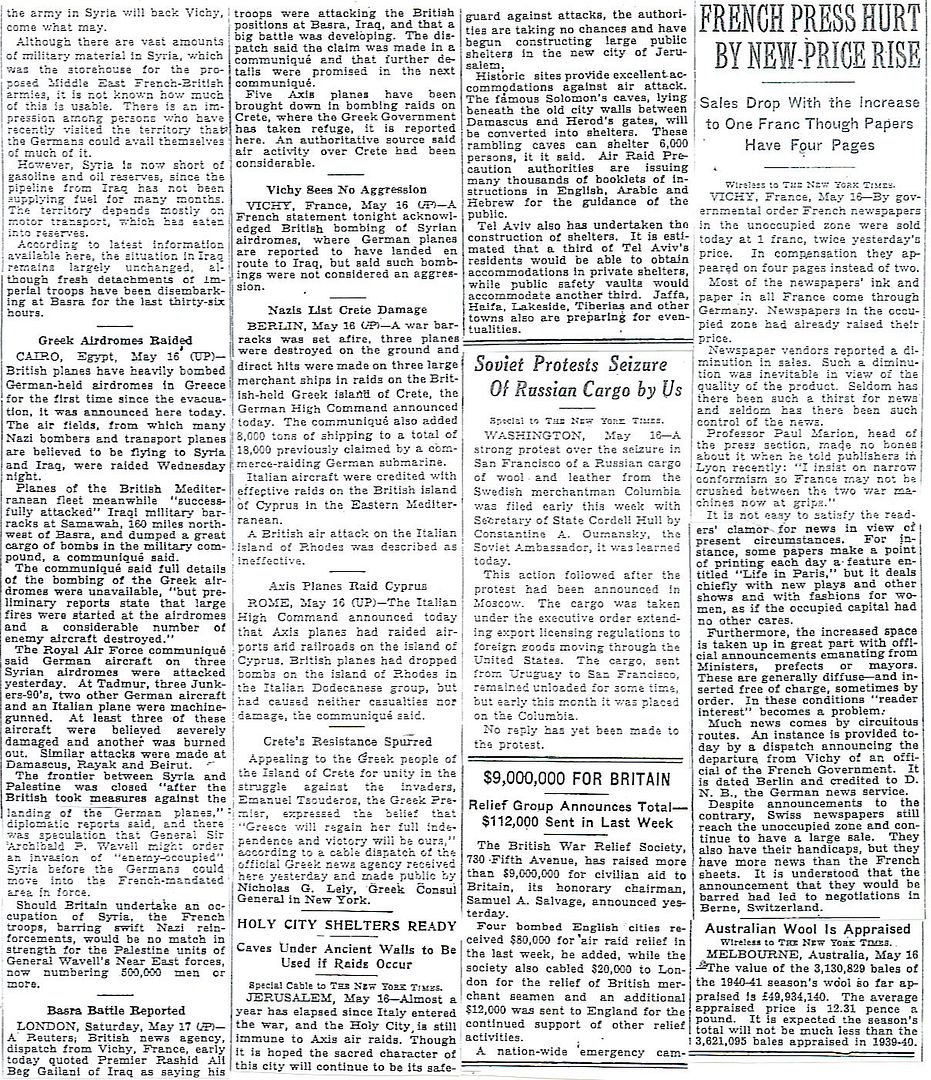
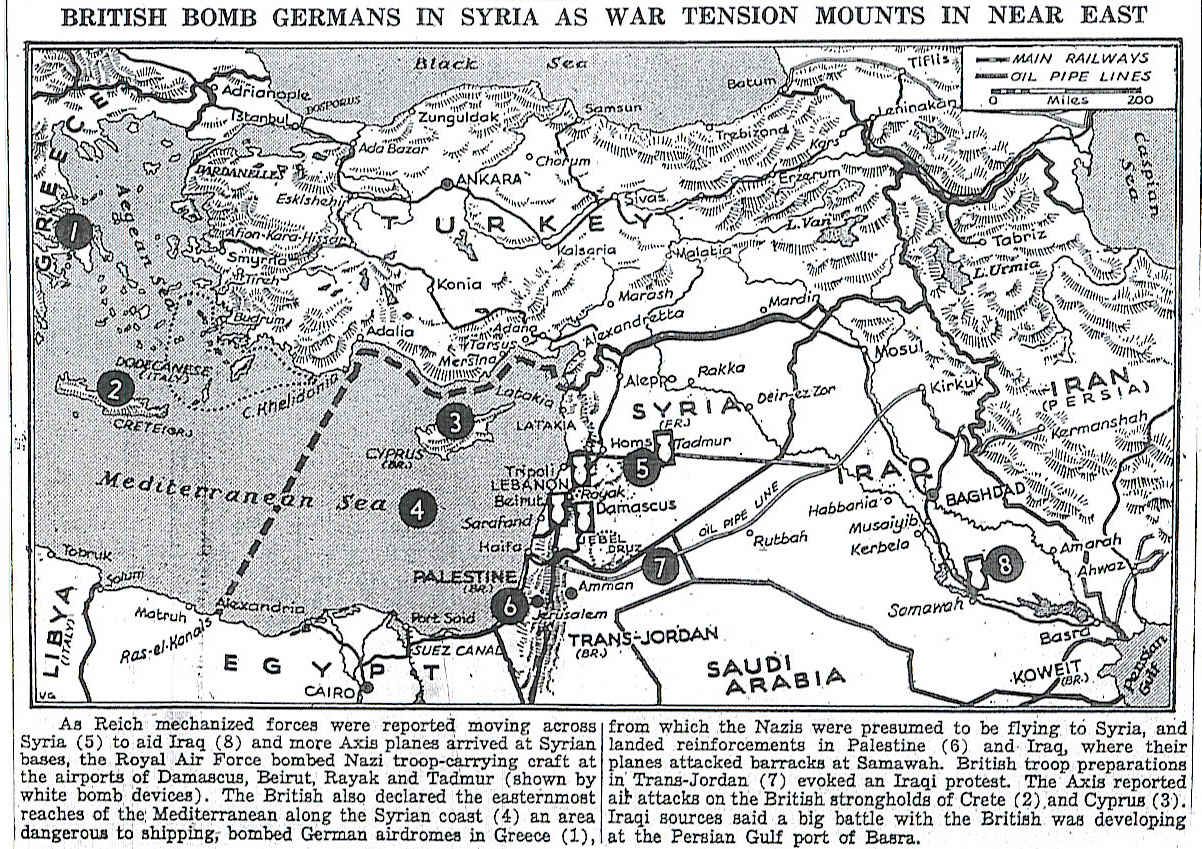
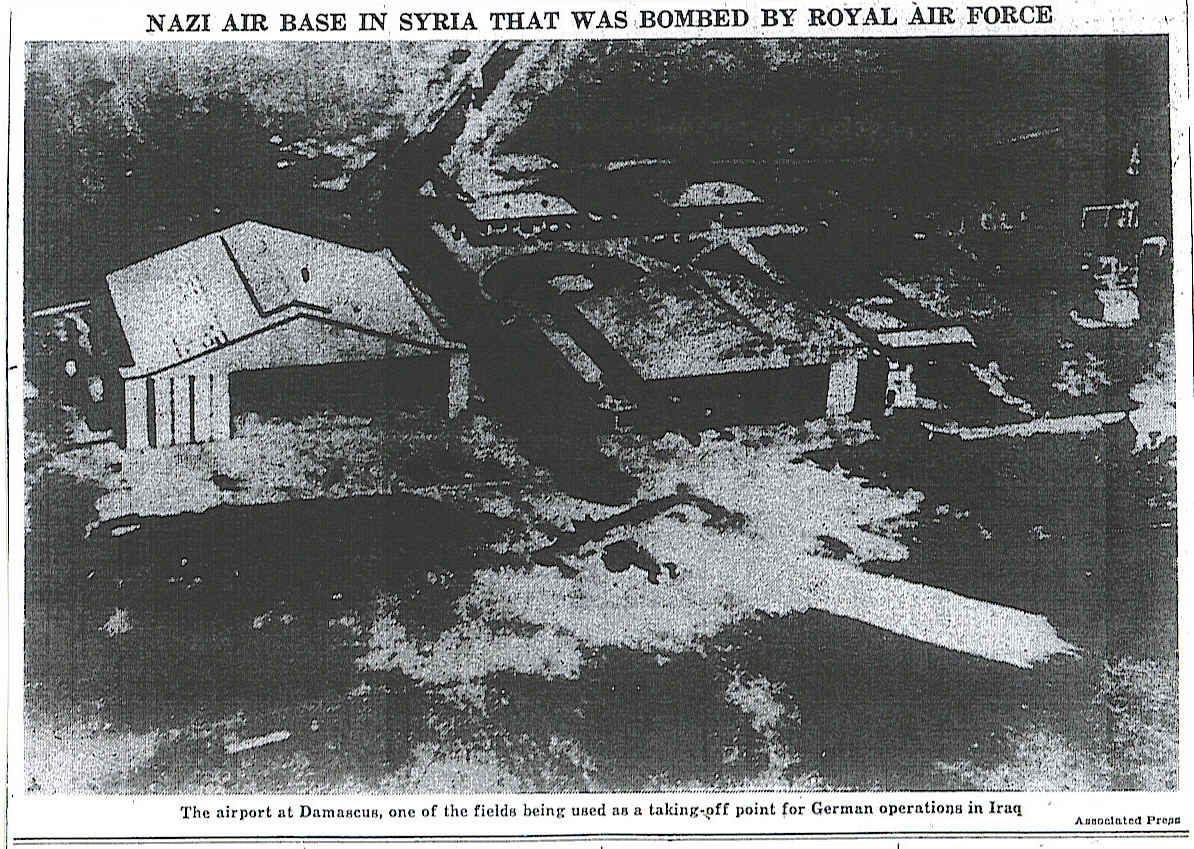


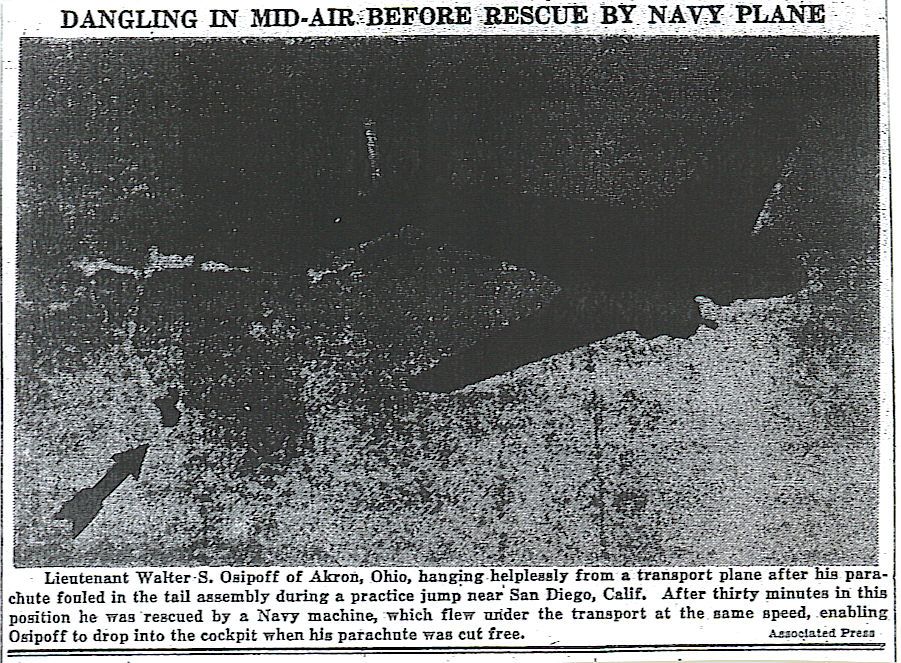
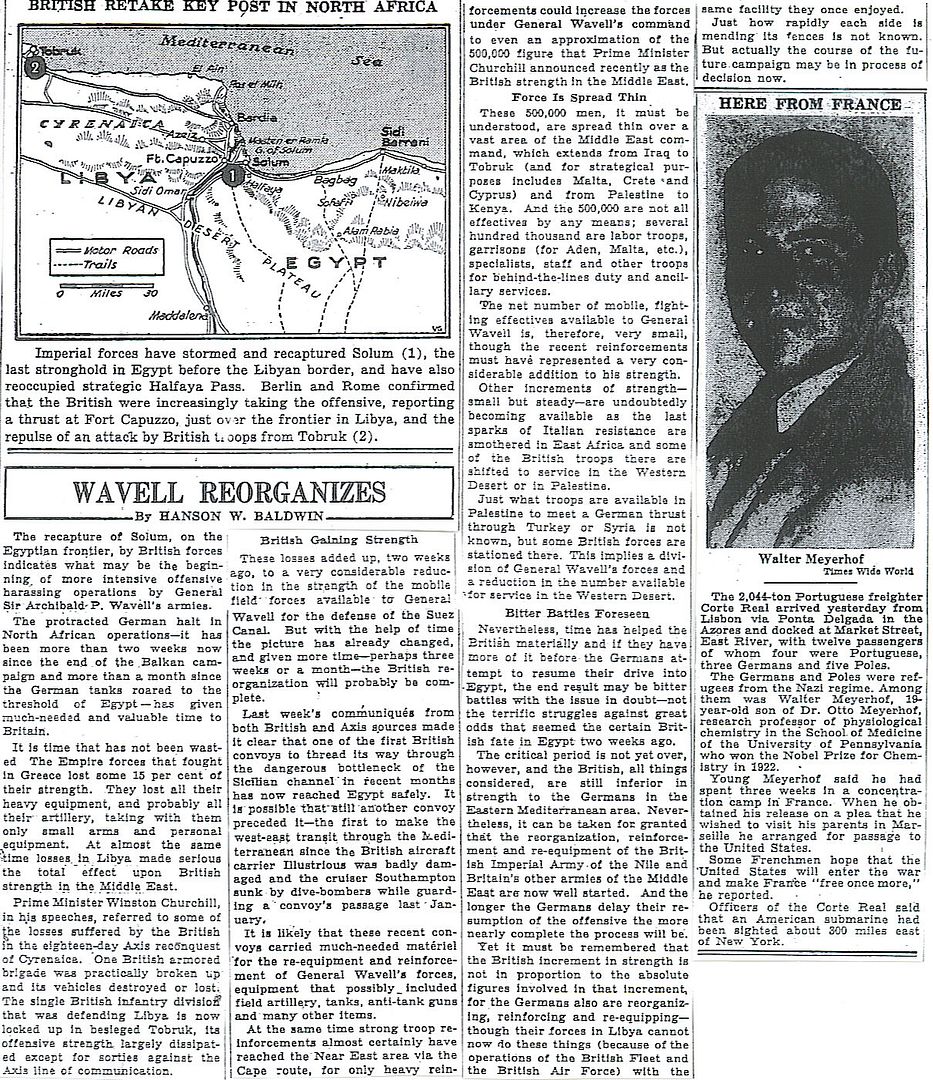
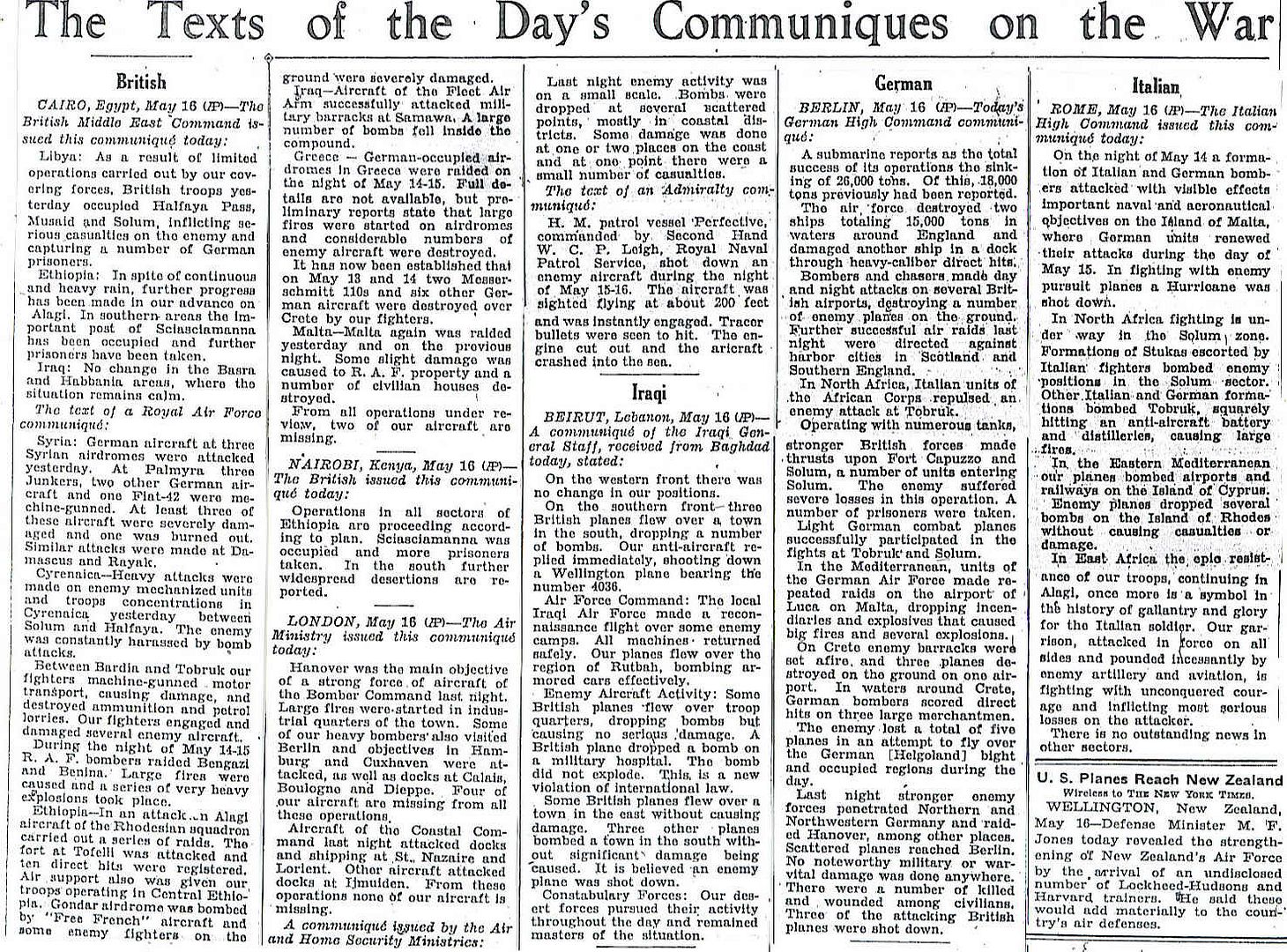
#1 – “Amapola” ((Pretty Little Poppy) - Jimmy Dorsey, with Bob Eberly and Helen O’Connell
#2 - “My Sister And I” - Jimmy Dorsey, with Bob Eberly
#3 - “G’Bye Now” – Horace Heidt, with Ronnie Kemper
#4 - “Dolores” – Bing Crosby and the Merry Macs
#5 - “I’ll Be With You in Apple Blossom Time” – The Andrews Sisters
#6 – “Green Eyes” - Jimmy Dorsey, with Bob Eberly and Helen O’Connell
#7 - “Intermezzo” – Wayne King
#8 – “Let’s Get Away From it All” – Tommy Dorsey, with Frank Sinatra, Jo Stafford and the Pied Pipers
#9 - “Oh Look at Me Now” - Tommy Dorsey, with Frank Sinatra and the Pied Pipers
#10 - “The Band Played On” - Guy Lombardo, with the Kenny Gardner Trio
* Crappy photo, wild story
http://www.onwar.com/chrono/1941/may41/f17may41.htm
Luftwaffe raids on Crete continue
Saturday, May 17, 1941 www.onwar.com
In the Mediterranean... The German air attacks on the island Crete continue. These are in preparation for the coming landing and are designed to subdue the garrison and compel the RAF to withdraw its few aircraft from Crete.
In Baghdad... The USSR concludes an agreement with the Iraqi government of Raschid Ali.
http://homepage.ntlworld.com/andrew.etherington/month/thismonth/17.htm
May 17th, 1941
UNITED KINGDOM:
London:
The prisoner in the Tower of London today is Rudolf Hess, brought by train from Scotland after his “peace flight” from Germany. he is kept in a room neat the White Tower and spends much of his time watching guardsmen drilling. he will remain in the Tower until a Hampshire country house has been fortified for his detention.
Hess has been examined by army psychiatrists who say that they believe that he sane, but his condition is deteriorating. He claims that attempts are being made to poison him. He dresses in his Luftwaffe uniform and insists that he should be given diplomatic status.
In Germany, Hitler has ordered the arrest of Willi Messerschmitt; Hess took off from the company airfield at Augsburg, but the aircraft chief knew nothing of his plan. Hess’s aides have also been arrested. Everybody, British and German alike, remains baffled by Hess’s flight to Scotland.
London: The Reuters News Agency reports:
As was made clear in a report on foreigners in the British armed services, approximately 10,000 US citizens are fighting under the British flag. Most of them are attached to the RAF as pilots, observers and aerial gunners, or assigned to the training camps. Some US citizens have joined the ranks of General de Gaulle’s Free French.
GERMANY:
Berlin: The German News Bureau reported:
Sollum, Capuzzo and Sidi Azeiz are once again in the hands of German and Italian troops.
U-212, U-261, U-465 laid down.
U-134 launched.
U-206 commissioned. (Dave Shirlaw)
U.S.S.R.:
Moscow: The Soviet TASS News Agency stated:
Foreign reports that the Soviet Union has authorised the recruitment of volunteer pilots for the Iraqi army, are completely false.
GREECE:
Athens-Tatoi airfield: During an RAF bombing attack the one remaining Junkers G38 transport of Lufthansa the ‘Generalfeldmarschal von Hindenburg’ is destroyed.
EGYPT:
Cairo: General Wavell announced:
On Thursday the RAF bombed the three Syrian airfields at Palmyra, Damascus and Rayak. Three German Junkers and two other unidentified German aircraft, as well as an Italian Caproni 42, were sighted at Palmyra airfield. We succeeded in seriously crippling three of these machines; a fourth was demolished with incendiary bombs. Regarding General Dentz’s communiqué, Wavell Headquarters has learned that one morning, 17 German aircraft landed at one Syrian airfield, and 5 at another field, and flew on in the direction of Iraq after refuelling. There is no question of the machines having been forced to make an emergency landing because the German aircraft were in impeccable condition. It is remarkable that General Dentz’s communiqué makes no mention of the results of the British raid on the airfield at Palmyra.
Cairo: The British Middle East Air Force in Egypt announced:
German aircraft have been fired on by machine guns at Mosul (Iraq). One German plane went up in flames, the others were damaged. We have set oil warehouses on fire at Al Amarah (Iraq). The RAF base of Habbaniya has been attacked by German aircraft, but damage was insignificant and the toll of victims was low. Our operations in Abyssinia were confined to reconnaissance flights and the bombardment of fortified positions.
COMMONWEALTH OF THE PHILIPPINES: First shipment of P-40’s (31 P-40B’s) arrives. No Prestone was included. These planes were unflyable. (Marc Small)
CANADA:
Corvettes HMCS Chicoutimi and Napanee arrived Halifax from builder Montreal, Province of Quebec.
Corvette HMCS Summerside launched Quebec City, Province of Quebec.
Corvette HMCS Dauphin commissioned. (Dave Shirlaw)
ATLANTIC OCEAN: At 0036, the unescorted Marisa was hit in the engine room by one torpedo from U-107. The U-boat had followed the tanker since 12.49 hours on 16 May. The explosion killed the fourth engineer C Kandel and a Chinese donkeyman and the remaining crewmembers abandoned ship in three lifeboats. The tanker was hit at 0115 by a coup de grâce in the stern, but did not sink. 15 minutes later, the U-boat opened fire with the 105-mm deck gun and hit the ship with 20 rounds, but the next grenade burst in the barrel and made the deck gun useless. The burning tanker settled by the stern, but the bow remained afloat. At 0217, the 20-mm AA gun was used to shoot holes in the empty tanks, until the weapon was damaged by a round that exploded in the barrel. A part of the barrel hit a man on the conning tower, but fell off without wounding him. Hessler wrote in the KTB - What kind of weapons and munitions do we have, we must be afraid of it. On 20 May, one lifeboat was found by HMS Columbine and a second by HMS Surprise. The third lifeboat with the master landed at the coast of French-Guinea on 23 May. The Marisa had arrived Freetown with a full cargo of oil on 11 May from Abadan, via Capetown. (Dave Shirlaw)
American officers of 15th Artillery/4th Marines, including Lt. Col Walter Osipoff (center), confering with Japanese commanders during the surrender of Kurihara Naval base after the capitulation of Japan.
http://worldwar2daybyday.blogspot.com/
Day 625 May 17, 1941
At midnight, U-107 stops Dutch tanker MV Marisa with a torpedo after following her for 12 hours (2 killed, 47 crew abandon ship in 3 lifeboats). U-107 sinks MV Marisa with the deck gun and antiaircraft gun but both guns are damaged when rounds explode in the barrel.
At 1 AM, Australian destroyer HMAS Vampire delivers fresh Australian troops to Tobruk, including 2/12th Field Regiment which is immediately pressed into action at 5.30 AM to support a failed probing attack on the German salient. This is the first time Australian artillery supports Australian infantry at Tobruk.
German invasion of Crete is delayed until May 20 by the late arrival in Southern Greece of tanker Rondine with 5,000 tons of aviation fuel.
At 5.30 PM, after 5 hours of negotiation, Duke of Aosta (Viceroy of Italian East Africa) agrees to a “surrender with honour” of the mountain fortress at Amba Alagi, Ethiopia. His troops will be allowed to march out with their rifles (to be surrendered later). In exchange, they will leave all artillery, weapons and stores intact and identify the location of all mines.
Iraq. Kingcol, the British mobile column from Palestine, arrives at Habbaniya late the evening. Overnight, elements of the Gurkha battalion, a company of RAF Assyrian Levies, RAF Armoured Cars towing captured Iraqi howitzers cross the River Euphrates using improvised cable ferries to advance 10 miles East on the town of Falluja.
http://www.hmshood.com/history/timeline4.htm
Career Timeline of H.M.S. Hood, Part 4
16-21 May: Based on reports that Bismarck was likely to attempt a breakout into the Atlantic, the ship was more-or-less on alert. Strategies were planned and discussed.
http://www.worldwar-2.net/timelines/war-at-sea/atlantic/battle-of-the-atlantic-index-1941.htm
17/05/1941 The German battleship Bismarck and the heavy cruiser Prinz Eugen leave Gotenhafen in the Baltic to begin operations against British convoys in the Atlantic (Operation Rheinübung).
Eastward from Pretzsch
In the spring of 1941 a police academy in Pretzsch, a town on the Elbe River about fifty miles southwest of Berlin, became the site of a sinister assembly.
Several thousand men from the ranks of the SS—the Nazi Party’s Schutzstaffel, or defense echelon, a police and security service that answered directly to Adolf Hitler and operated outside the constraints of German law—were ordered to report to Pretzsch for training and assignment.
They were not told what their assignment would be, but their commonalities offered a clue: many of them had served in SS detachments in Poland, which Germany had invaded and occupied in 1939, and preference was given to men who spoke Russian.
Assignment to Pretzsch emptied the SS leadership school in Berlin-Charlottenburg and depleted the professional examination course of an SS criminal division. It drew in lower-and middle-ranking officers of the Security Police (the Gestapo and the criminal police), some of them passed on gratefully by their home regiments because they were considered too wild. The Waffen-SS, the small but growing SS army, contributed enlisted men. High-ranking bureaucrats within the shadowy Reich Security Main Office, an internal SS security agency, were posted to Pretzsch as well.
They had been handpicked for leadership positions by Obergruppenführer Reinhard Heydrich, the head of the RSHA and the second most powerful man in the SS, and his superior Heinrich Himmler, the Reichsführer-SS.
Most of these handpicked leaders were lawyers, and a few were physicians or educators; most had earned doctoral degrees. Among the more exotic specimens were Otto Ohlendorf, a handsome but argumentative young economist who had fallen into disfavor with Himmler; Paul Blobel, a rawboned, highstrung, frequently drunken architect; Arthur Nebe, a former vice squad detective and Gestapo head who had enthusiastically volunteered; and Karl Jäger, a brutal fifty-three-year-old secret police commander. A reserve battalion of the regular German Order Police (uniformed urban, rural and municipal police) completed the Pretzsch roster.
Soon the men learned that they would be assigned to an Einsatzgruppe—a task force. Einsatz units—groups and commandos—had followed the German army into Austria, Czechoslovakia and Poland when Germany had invaded those countries successively in 1938 and 1939. Einsatzgruppen secured occupied territories in advance of civilian administrators. They confiscated weapons and gathered incriminating documents, tracked down and arrested people the SS considered politically unreliable—and systematically murdered the occupied country’s political, educational, religious and intellectual leadership.
Since Germany had concluded a nonaggression pact with the Soviet Union in August 1939, many of the candidates at Pretzsch assumed they would be assigned to follow the Wehrmacht into England. Some of them had previously trained to just that end.
Masters of Death by Richard Rhodes
The following is from The German Raider Atlantis by Wolfgang Frank & Captain Bernhard Rogge:
On 17th May we were standing along the innermost of the courses which, according to a captured English chart, were available to ships on passage between Capetown and Freetown.
Following a habit we had acquired in the Indian Ocean, we had stopped engines and were drifting to save fuel. After the evening sing-song and the last rounds, a deep peace settled over the ship. The moon was very bright and visibility good. If anything turns up, I thought, we'll see it soon enough.
And shortly after midnight we did!
The coxswain and a signalman reported it almost simultaneously.
First one, then two humps appeared on the horizon, which grew into two large, blacked-out ships steaming in line ahead. I had been half asleep on the bridge-deck and as soon as the message reached me, I sounded the alarm.
The ships were heading straight towards us.
Any illusion that we had two big merchant ships in front of us quickly vanished. We were soon able to pick out the triangular silhouettes of warships, steaming in close order in line ahead at fourteen knots, between us and the moon.
Fortunately the moon was shining right on us, making us more difficult to see; it is when the moon is behind you that it becomes dangerous. As we moved slowly ahead on the engines, being careful not to show any sparks, and gradually steered to starboard of the enemy, the silhouettes stood out even more clearly. One of them looked like an unusually powerful ship, the other loomed up as a giant rectangle—an aircraft-carrier!
'That's no cruiser,' I cried, 'that's a Nelson class battleship!'
I could clearly see the characteristic bows with the triple turrets. At that moment Commander Lorenzen arrived, rather out of breath, on the bridge. It was his job to make accurate notes of every order given in an action, for inclusion in the subsequent report. He had to wait a few seconds before his eyes grew accustomed to the dark, but as soon as he saw what was in front of us he realized what it signified.
'There are two of them, sir,' he gasped in a horrified voice, 'and isn't one of them a carrier?'
Despite the gravity of the situation, I could hardly keep from laughing and said, 'Really, Lorenzen, you don't miss a thing, do you?'
Just then the voice-pipe from the engine-room croaked, What's happening up on the bridge? There seem to be two ships out there.
Aren't you going to attack them?'
'The two ships,' said the officer of the watch, 'are a battleship and a carrier.' The questioner was left speechless.
The enemy came up so quickly that they must have seen us; if we had remained stopped they would have rammed us. But they altered course and passed astern of us; no one dared breathe during those seemingly endless minutes while we expected at every instant that they would alter course again and turn their searchlights on us—after which the end would come quickly. But nothing happened. The range was scarcely 7,000 yards and through our glasses we could see the battleship's bow-wave. A single shell from her sixteen inch guns would have blown us to atoms. We still did not dare to steam at full speed for fear of betraying our position by sparks; but very gradually we increased speed and turned slightly away, and at last the two ships disappeared over the horizon. I leaned over and spoke into the internal relay system.
'Attention all hands! Both enemy capital ships are now barely visible even through the best nightglasses.'
From somewhere in the darkness came the voice of the ship's wit, Then they ought to use day-glasses on the bridge so that they can see even less!' Our pent-up emotions found relief in a gale of laughter that swept through the ship.
We were still getting our breath back when a spout of flame suddenly shot up from the funnel. Some rust had got loose and caught fire, showering the whole ship with a rain of sparks. There was a yell of 'Stop both engines!' but even so the sparks did not go out at once and, holding our breath once again, we looked alternately up at them and in the direction of the enemy. All was well.
Next morning-—Sunday—the horizon was clear. I ordered 'make and mend clothes' and held Divine Service, in which I offered up a special prayer of thanksgiving for our deliverance. We learned later that the Nelson and Eagle were on their way from Walvis Bay to St. Helena. As a matter of fact, I had already been alerted by a secret service report, which had hinted that these two ships might be near Capetown.
Thanks for the ping Homey...:)
Fascinating story!
http://www.naval-history.net/xGM-Chrono-01BB-Nelson.htm
SERVICE HISTORIES of ROYAL NAVY WARSHIPS in WORLD WAR 2
by Lt Cdr Geoffrey B Mason RN (Rtd) (c) 2003
HMS NELSON - Nelson-class 16in gun Battleship
May 18, 1941 At 0015 hours in 9.07S,04.42W,approximately 226 miles south of St Helena the raider ATLANTIS, which at the time was stationary, sighted two darkened vessels approaching at speed.
ATLANTIS identified them as warships and moved slowly out of their path. The vessels she sighted were NELSON and EAGLE, and they passed within 7000 metres of her without either vessel sighting ATLANTIS.
At 1100 hours arrived at St Helena to refuel. At 2345 hours following refuelling departed St Helena to proceed to Freetown in company with EAGLE.
Nebe never commanded the Gestapo. That was Heinrich Mueller’s bailiwick. Nebe commanded the Kriminalpolizei [Criminal Police] side of the Sicherheitspolizei [Security Police]., which was under Heydrich’s direct command, and inclided the Gestapo, Kriminalpolizei, and the Sicherheitsdienst [SS SD, the SS Security Service]. The uniformed police [Ornungspolizei-Order Police] was a separate entity commanded by Kurt Daleuge. Several order police regiments were also sent to Russia.
Among the “more exotic specimens” of Einsatzkommando officers were a former opera singer, and a former Protestant Minister.
Ohlendorf was not only an economist. He also had a law degree.
So BISMARCK’s on the move.
One other timeline gives the date as 5/18.
18 May 1941 (Sunday): Operation Rheinübung commences.
1200. Leaves the berth in Gotenhafen and anchors in the bay to embark supplies and fuel.
http://www.kbismarck.com/histoperi.html

It’s hard to believe that both warships passed as close as 7000 meters from Atlantis and the lookouts, and radar (I presume) entirely missed her. I’m wondering if she was sighted but the warships assumed she was an ordinary freighter.
May 18th was also the date I’ve always read that the Rhine Exercise started.
Disclaimer: Opinions posted on Free Republic are those of the individual posters and do not necessarily represent the opinion of Free Republic or its management. All materials posted herein are protected by copyright law and the exemption for fair use of copyrighted works.